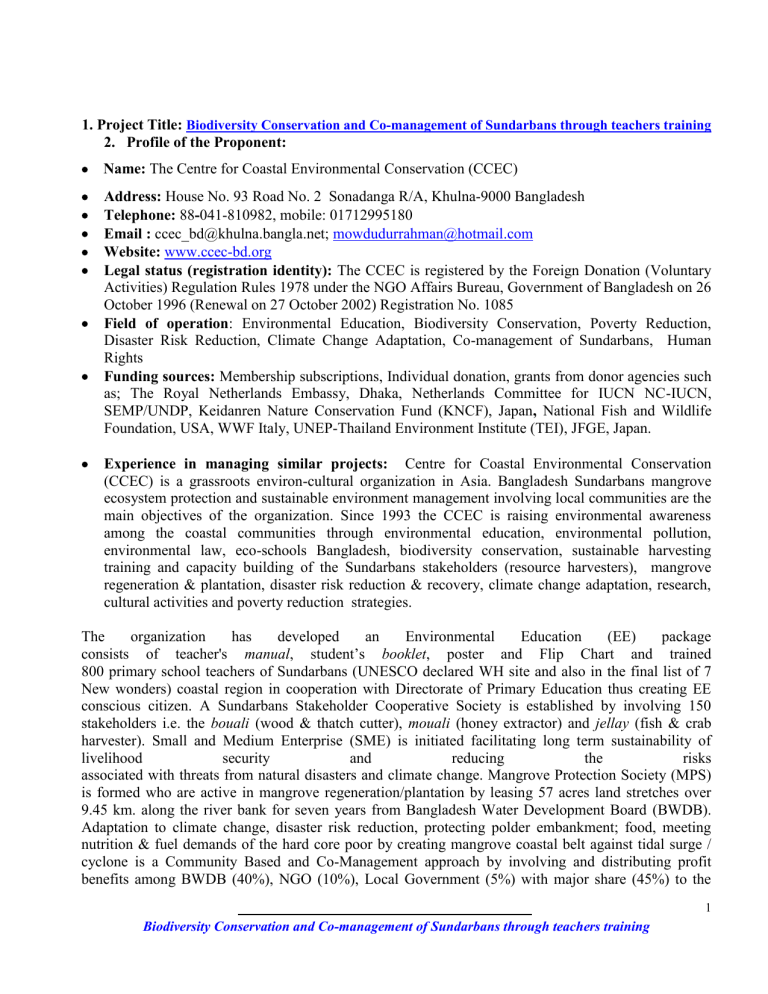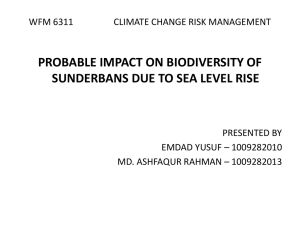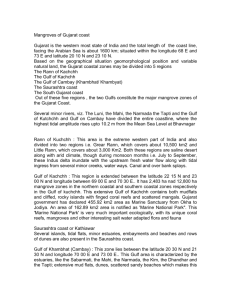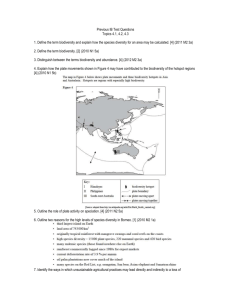EE5 - Biodiversity conservation and Sundarbans Co

1. Project Title: Biodiversity Conservation and Co-management of Sundarbans through teachers training
2.
Profile of the Proponent:
Name: The Centre for Coastal Environmental Conservation (CCEC)
Address: House No. 93 Road No. 2 Sonadanga R/A, Khulna-9000 Bangladesh
Telephone: 88 041-810982, mobile: 01712995180
Email : ccec_bd@khulna.bangla.net; mowdudurrahman@hotmail.com
Website: www.ccec-bd.org
Legal status (registration identity): The CCEC is registered by the Foreign Donation (Voluntary
Activities) Regulation Rules 1978 under the NGO Affairs Bureau, Government of Bangladesh on 26
October 1996 (Renewal on 27 October 2002) Registration No. 1085
Field of operation : Environmental Education, Biodiversity Conservation, Poverty Reduction,
Disaster Risk Reduction, Climate Change Adaptation, Co-management of Sundarbans, Human
Rights
Funding sources: Membership subscriptions, Individual donation, grants from donor agencies such as; The Royal Netherlands Embassy, Dhaka, Netherlands Committee for IUCN NC-IUCN,
SEMP/UNDP, Keidanren Nature Conservation Fund (KNCF), Japan , National Fish and Wildlife
Foundation, USA, WWF Italy, UNEP-Thailand Environment Institute (TEI), JFGE, Japan.
Experience in managing similar projects: Centre for Coastal Environmental Conservation
(CCEC) is a grassroots environ-cultural organization in Asia. Bangladesh Sundarbans mangrove ecosystem protection and sustainable environment management involving local communities are the main objectives of the organization. Since 1993 the CCEC is raising environmental awareness among the coastal communities through environmental education, environmental pollution, environmental law, eco-schools Bangladesh, biodiversity conservation, sustainable harvesting training and capacity building of the Sundarbans stakeholders (resource harvesters), mangrove regeneration & plantation, disaster risk reduction & recovery, climate change adaptation, research, cultural activities and poverty reduction strategies.
The organization has developed an Environmental Education (EE) package consists of teacher's manual
, student’s booklet , poster and Flip Chart and trained
800 primary school teachers of Sundarbans (UNESCO declared WH site and also in the final list of 7
New wonders) coastal region in cooperation with Directorate of Primary Education thus creating EE conscious citizen. A Sundarbans Stakeholder Cooperative Society is established by involving 150 stakeholders i.e. the bouali (wood & thatch cutter), mouali (honey extractor) and jellay (fish & crab harvester). Small and Medium Enterprise (SME) is initiated facilitating long term sustainability of livelihood security and reducing the risks associated with threats from natural disasters and climate change. Mangrove Protection Society (MPS) is formed who are active in mangrove regeneration/plantation by leasing 57 acres land stretches over
9.45 km. along the river bank for seven years from Bangladesh Water Development Board (BWDB).
Adaptation to climate change, disaster risk reduction, protecting polder embankment; food, meeting nutrition & fuel demands of the hard core poor by creating mangrove coastal belt against tidal surge / cyclone is a Community Based and Co-Management approach by involving and distributing profit benefits among BWDB (40%), NGO (10%), Local Government (5%) with major share (45%) to the
1
Biodiversity Conservation and Co-management of Sundarbans through teachers training
MPS members. As the lead environmental NGO (Cell Member) of Department of Environment (DoE),
Khulna Division, it has signed Memorandum of Understanding (MOU) with a) Center on Integrated
Studies of the Sundarbans (CISS), Khulna University, b) Soil Resources Institute (SRDI),Ministry of
Agriculture, c) Bangladesh Water Development Board (BWDB) for mangroves restoration, d)
Bangladesh Environmental Lawyer's Association (BELA) for advocacy. With a view to generate income for the disadvantaged women, it has launched Sundarbans Handicraft (SME) involving indigenous munda and socially deprived rishi women communities thus initiated producing Sundarbans tourist’s souvenir such as tea shirt, school bag, wall mat with wildlife (tiger, deer) logo. With funding from UNEP, the organization has represented “
Regional Stakeholders Meeting cum Regional
Coordination Meeting” under Male Declaration on Control and Prevention of Air pollution and its likely Trans-boundary Effects for South Asia (Buhtan and Maldives). Sustainable Environment
Managemnt Programme (UNDP/SEMP) funded project titled
“Environmental pollution awareness among the industrial workers” was effective in cooperation with Ministry of Environment and Forests
(MoEF), Government of Bangladesh. In recognition to community based success stories, CCEC receives international Whitely Award and become the member and partners of International Union for
Conservation of Nature (IUCN), Mangrove Action Project (MAP) and Poverty and Conservation
Learning Group (PCLG) facilitated by the International Institute for Environment and Development
(IIED). It is affiliated with International Centre for Climate Change Adaptation and Development
(ICCCAD) for field demonstration on climate change adaptation examples. Recently
“Sundarbans crab fattening in bamboo cages and mangrove restoration as an adaptation to climate change” project proposal has been awarded for the UNEP-APFED Showcase programme. The organization took a lead role to observe Earth-Hour- 2010 from Bangladesh with the participation of Khulna City Corporation.
Currently the organization is implementing the project “Biodiversity Focusing Tiger Conservation at
Bangladesh Sundarbans in Response to Global Climate Change Impacts” funded by Japan Fund for
Global Environment (JFGE).
Project Area/Target Population: Satkhira, Khulna and Bagerhat districts of Bangladesh / 400 schools teachers from Sundarbans Cluster ( schools of Satkhira/Burigoalini, Khulna/Nalian,
Chandpai and Saronkhola FD Range areas) / 800 stakeholder guardians .
1.
Problem Statement :
The Sundarbans with an area of 10000 sq. km. shared between two neighboring countries Bangladesh
(62%) and India (38%) is a swamp mangrove ecosystems (70% terrestrial and 30% aquatic) and home to a variety of migratory birds, crustaceans, reptile and invertebrate species including salt water crocodile. The
Sundarbans is an ideal habitat for a variety of mammals, waders and seabirds and also the nesting sites for both marine turtles (Lepidochelys olivacea) (Blower, 1985). Biogeographically Masked Finfoot (Heliopais
personata) is the only species of sub-Himalayan region found in the Sundarbans. The Sundarbans is a
Wetlands of International Importance (Ramsar site) that are also an UNESCO declared World Heritage site.
2
Biodiversity Conservation and Co-management of Sundarbans through teachers training
Both natural and anthropogenic causes making the Sundarbans endangered. Bangladesh is a high risk country due to sea level rise caused by global climate change. Sundarbans including the tigers are vulnerable to inundation. Unsustainable harvesting practices violating occupational ethics by the stakeholders hamper natural regeneration of Sundarbans resources and its production which in turn depleting biodiversity. Hog deer (Axis porcinus), water buffalo (Bubalus bubalis) , swamp deer (Cervus duvauceli) , Javan rhinoceros (Rhinoceros sondaicus) , single horned rhinoceros (Rhinoceros unicornis) and the mugger crocodile (Crocodylus palustris) have become extinct
in the Sundarbans at the beginning of the last century. The endangered species that lives within the Sundarbans are
Bengal tiger, estuarine crocodile, river terrapin (Batagur baska), olive ridley turtle, Gangetic dolphin, ground turtle, hawks bill turtle and King crab (Horse shoe). Biodiversity depletion and biodiversity conservation involving local people is a global concern for sustainable management of the protected areas (PA).
Natural balance of Bangladesh environment is mostly dependent on Sundarban. But this motherly mangrove forest is sick now. Top dying in Sundri ( Heritiera fomes ), increased salinity, sea level rise including many destructive practices made by the stakeholders for example use of samboose, a chemical used by the fishermen, cutting down the central leaf of thatch ( Nypa fruticans ) by the non-professional wood/thatch cutter, setting traps for deer killing, use of strong poison within food for tiger killing by the poachers/hunters, killing of lizards by the crab collectors. “ The disappearance of Sundarban which is the only thing stopping Bangladesh from sliding into the Bay of Bengal would be an ecological catastrophe
.” warned Keith Burd, Director, British Council in Bangladesh recently.
There is an urgent need to conserve the Sundarbans from being endangered without any further delay.
Rationale:
Co-management of natural resources ensuring sustainability is a demand for now a day especially in third world countries such as Bangladesh. The United States Agency for International Development
(USAID) assisted Integrated Protected Area Co-Management (IPAC) project is currently working in
Sundarbans Cluster towards co-management involving different stakeholders thus teachers training or education is one of the path way to achieve co-management objectives of IPAC.
Education and training is the best medium for communicating messages into the society as it disseminates knowledge, provides necessary skills and helps in forming attitudes. Education is a top priority for families entering a new community and Environmental Education (EE) is an integral part of education that touches every aspects of life from daily actions and deals human interrelationships with the environment. EE is seen as a process in which individuals gain awareness of their environment and acquire/exchange also the determination, which will enable them to act individually/collectively to solve present/future environmental problems. A large number of teacher/student(s) are associated in the education systems of Bangladesh. Teachers are the ideal to the society. Once the teachers inculcate the concept of conservation ethics it will be communicated to the students. Students are the future generation to a nation who plan, decide and rank the issues to be addressed based on the country’s need.
CCEC feels to use the EE package (teacher’s manual, students booklet and poster) which it has already prepared and published by including and focusing the fundamental issues with explaining the causes, origins, consequences and the remedies with facts and figures both in text (manual) and in illustration
(booklet) for school teachers as an environmental guide/reference book including recently developed beautiful Sundarbans Flip Chart and CD on Tiger conservation. Again the justification of doing this exercise by using this EE package is that the existing curriculum and materials on environment
3
Biodiversity Conservation and Co-management of Sundarbans through teachers training
conservation/Sundarbans protection in the education systems in Bangladesh is not adequate and teachers with sound knowledge on environment/biodiversity/ nature education is lack.
There is a demand and request to reprint the “Sundarbans Flipchart” prepared and produced by the proposed organization as because the Flipchart is published with 19 rhymes with colorful pictures with key messages on Sundarbans. It is a unique publication and awesome document for Sundarbans learning by reading the trees, plants and wildlife resources. It is an excellent document in its kind recommended by IUCN Bangladesh and Primary Education Department.
5. Project Objectives:
1. Development of Sundarbans conservation ethics by teachers, children, guardians and the society members
2.
Promote Sundarbans Co-management approach involving teacher, student and guardians
3.
Networking multi-stakeholders for Sundarbans conservation
6. Implementation Procedure
The Centre for Coastal Environmental Conservation (CCEC) will implement this project for a period of seven months by covering 400 school teachers of Primary School under Satkhira, Khulna and Bagerhat coastal Districts of Sundarbans region. Sundarbans Flipchart prepared and produced by CCEC will be reprinted. A number of important messages such as Sundarbans mangroves role in maintaining the ecological balance of Bangladesh including Sundarbans is an important resource, UNESCO has declared it as World Heritage Site, Livelihood for the bouali (thatch and wood cutter), mouali (honey extractor) and jellay (catch fish and crab) including environmental degradation and climate change i.e/ high risk issues of the south-west coastal region of Bangladesh will be focused. The idea of this mangrove ecosystem conservation education and training for the school teachers on Sundarbans threat messages i.e. Sundarbans endanger, Biodiversity loss, destruction of tiger habitat, increased salinity, seal level rise and USAID assisted IPAC project and need for co-management approaches involving different stakeholders. There is an urgent need for the conservation of coastal mangrove ecosystems with participation by all sections of the society into the vast number of teacher- student-guardian communities with priority to co-management.
During first two months of the project, meetings with the Directorate of Education and Forest
Department (FD) will take place at the concerned Departments regarding the aims and objectives of the project including the preparation of a list of 400 (200 male and 200 female) science teachers in cooperation with Primary Education and IPAC. Colorful Sundarbans Flipchart will be reprinted during this period. Training for the teachers will take place in the second two months in consultation with education department, forest department, Khulna University and Primary Training Institute. 400 teachers will be divided into 10 batches by taking 40 teachers in each batch. A two-days training for each batch will take place thus 20 training sessions will be held altogether. Two resource persons preferably from Khulna University and Primary Training Institute (PTI) will deliver lectures to each training groups. Each teacher will give a sincere task to select two Sundarbans stakeholders (bouali,
4
Biodiversity Conservation and Co-management of Sundarbans through teachers training
mouali, and jellay) thus 800 (400 x 2) stakeholders will be communicated on Sundarbans conservation ethics and co management aspects. Follow up of the training especially the 2000 stakeholder guardians will be carried out in 5-6 months. A seminar will be conducted at the end month of project. Final and financial report will be submitted within two months after the completion of project. An agenda is enclosed with this proposal for the training. A structured questionnaire will be administered both in the pre and post training period for evaluation of teachers on the status on Sundarbans mangrove knowledge and Co-management concept.
7. Project Manager’s qualification:
CV of the key personnel is attached
8. Monitoring and Evaluation Plan:
Besides the communication and evaluation of training into the school systems (formal and non-formal), the project will monitor the project involving 2000 guardians using structured questionnaires for communicating the importance of Sundarbans conservation and justification of co-management for
Sundarbans. Links will be established with Forest Department (FD), Department of Fisheries (DoF),
Bangladesh Water Development Board (BWDB), Coast Guard, Peoples Representatives, Local
Administration, and Union Parishad (UP) for fostering co-management of Sundarbans.
9. Work plan/Time frame:
Activity
Period (Month)
1-2
List of 400 teachers from Sundarbans cluster of Khulna/
3-4
Bagerhat/ Satkhira districts.
Meetings with Education Department, FD, DoF, BWDB and
NGOs
Printing of Sundarbans Flipchart
Training of Teachers
20 training for 400 teachers including Sundarban Information
5-6
7
Centre visits
Follow up 800 Sundarbans stakeholders focusing comanagement
Seminar / Report submission/ Recommendation of key
Flipchart messages for integration into the school curriculum
10. Project Output and follow up Activities:
Conservation ethics of Sundarbans Reserved Forest (SRF) with priority to Co-management approaches of 400 teachers and 800 guardians of Sundarbans cluster is improved which in turn lead them to act towards Sundarbans protection. The Mangrove Education materials received and experience gained by the project will be integrated with CCEC’s regular program such as Biodiversity Conservation
Awareness, Environment Conservation Awareness among the crab collectors so that the messages be communicated over the years among the large number of beneficiaries in the existing project and new project areas in future without any follow up cost. Since CCEC works with coastal communities of
5
Biodiversity Conservation and Co-management of Sundarbans through teachers training
Khulna, Bagerhat and Satkhira districts and experienced in teachers training, will keep on disseminating mangrove education messages in the locality even after the project is over. Again a vast number of teacher-students will read, learn and practice the environment friendly behaviors, strategies in their daily life with the integration of conservation education with Co-management into the education system.
12. Breakdown of the itemized budget:
Item
Project Manager Tk. 15000/month x 7
Cost (Tk.)
105000
210000
400000
Organizer/Trainer (3) Tk. 10000/month x 7
Transport and Honorarium for Teachers 400 x
1000
Lunch/Dinner/Breakfast/Tea during Training (3 dinner/ 2 lunch/2 breakfast/6tea
5 meals x 400 x Tk.200
2 breakfast x 400 x Tk. 50
6 tea/snacks x 270 x Tk. 50
Accommodation for teachers Tk. 300 /night x 2 night x 400
560000
240000
120000 Training materials for teachers (bag, pen, pad, others) 300 x 400
Training hall rent Tk. 7000/day x 20 days
Certificate for teachers 400 x Tk. 50
Questionnaire printing for Pre/post testing
Fee for Resource Persons (Director, DPO, Trainer from PTI, Teacher from Khulna University)
Poster
Colorful Sundarbans Flipchart (2000/copy x 450)
Festoon for training room
Postage/fax/email/phone/mobile, stationeries (pen, paper, plastic cover, box file, follow up guardians
Tk. 10000 x 7
Seminar
Total
Contingency (5% of the total)
Grand TOTAL
140000
20000
8000
60000
66000
900000
5000
70000
50000
2954000
147700
3101700
Amount requested from EE5 is TK. 3101700= 31017 Euro
(1 Euro =Tk.100 approx.)
6
Biodiversity Conservation and Co-management of Sundarbans through teachers training
ANNEX:
Time
9.00 – 9.30 am
9.30-10:00
10.00 am –10:30 am
10.30 am –1: 00 pm
1.00-2.00 pm
2.00-3.00
3.00- 4.00
4.00-4.30
Time
9.30– 10.30 am
10.30-11.00
11.00 am –1.00 pm
1.00-2.00 pm
2.00-3.00
3.00- 4.30
4.30-5:00
Agenda for the teachers training
Ist Day
Title of the lectures
Registration
Introduction and pre testing
Tea
Sundarbans conservation Issues-part I
/Sundarbans Information Centre visit
Lunch break
Sundarbans Co-management Issues – Resource
Persons
Video Pot song on Sundarbans
End of the 1 st day and Tea
2 nd Day
Title of the lectures
Sundarbans conservation issues-part II
Tea
Group work on Sundarbans Co-management
Lunch break
Open discussion/case studies
Review of the courses /post evaluation/ Certificate distribution ceremony/Evaluation of the workshop by the participants
Tea and closing remarks
Biodiversity Conservation and Co-management of Sundarbans through teachers training
7
Biodiversity Conservation and Co-management of Sundarbans through teachers training
8









